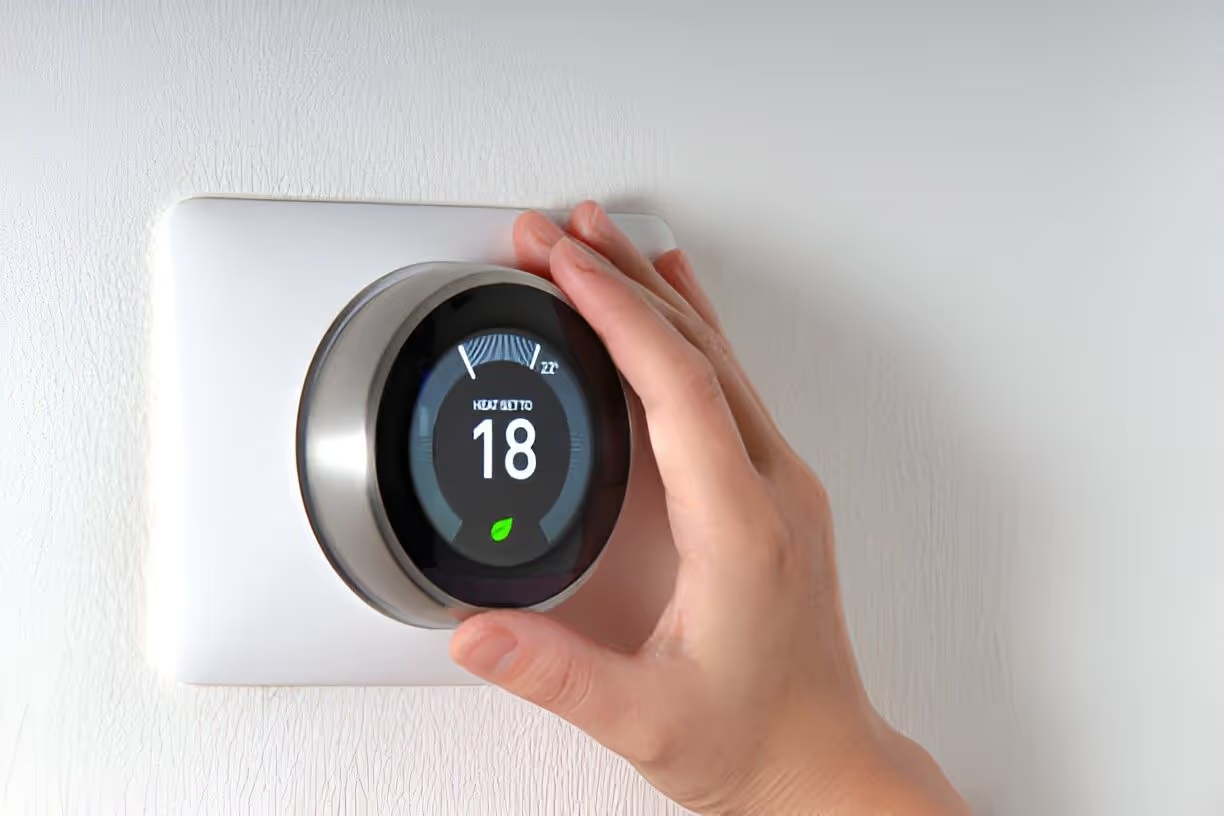Smart Thermostats in Bradenton, FL


Why choose a smart thermostat in Bradenton, FL
- Cooling-first benefits: Bradenton’s hot, humid weather means HVAC systems work hard. Smart thermostats optimize cooling cycles, reduce short-cycling, and maintain setpoints more efficiently, improving comfort and equipment lifespan.
- Remote control and geofencing: Control your system from anywhere and use geofencing so your thermostat automatically shifts to energy-saving settings when everyone leaves and returns home.
- Energy reporting and insight: Detailed usage reports show when and how your HVAC consumes energy, making it simpler to identify hours or settings that drive bills up.
- Smart-home integrations: Most smart thermostats work with Alexa, Google Assistant, and Apple HomeKit, and can be included in scenes with smart shades, fans, or humidity monitors for unified climate control.
Common smart thermostat types and features
- Learning thermostats: Automatically create schedules by observing your habits. Good for homeowners who prefer set-and-forget operation.
- Programmable smart thermostats: Offer remote scheduling, energy reports, and manual schedule setup without autonomous learning.
- Wi-Fi enabled thermostats: Focus on remote control and energy tracking through apps and dashboards.
- Compatibility-focused models: Designed to integrate with complex HVAC setups, multi-stage systems, heat pumps, and systems requiring a common wire (C-wire).
Key features to look for:
- Remote mobile app control
- Adaptive learning schedules
- Energy usage and savings reports
- Geofencing and presence sensing
- Multi-stage and heat pump compatibility checks
- Integration with smart-home ecosystems
- Alerts for maintenance and filter changes
HVAC compatibility and pre-installation checks
Before replacing your thermostat, a compatibility check is essential to ensure reliable performance with your HVAC system. A professional assessment in Bradenton typically includes:
- Visual inspection of existing thermostat wiring and control board
- Verification of a C-wire or use of a compatible power adapter
- Determination of single-stage vs multi-stage systems, and heat pump vs conventional split systems
- Confirmation that your air handler and outdoor unit communicate correctly with smart controls
- Evaluation of existing zoning systems, humidifiers, or dehumidifiers that may be tied into thermostat controls
Older thermostats or nonstandard wiring are common causes of installation complications. Addressing these during the assessment prevents power issues, Wi-Fi drops, and incorrect equipment behavior.
Installation and integration process
A reliable installation follows a clear sequence to protect your HVAC equipment and ensure a stable smart system:
- System assessment: Inspect system, wiring, and service history to choose the right thermostat model.
- Compatibility verification: Confirm thermostat supports your furnace, AC, or heat pump stages and accessories.
- Safe wiring and power setup: Install or adapt a C-wire if needed, or use a manufacturer-recommended power module.
- Mounting and setup: Replace the old thermostat, mount the smart unit, and power it up following manufacturer safety checks.
- Network and cloud setup: Connect device to secure Wi-Fi, create accounts, and enable required cloud services as needed.
- Integration with smart-home: Link to Alexa, Google, or Apple systems and configure routines, geofencing, and third-party integrations.
- Testing and calibration: Run system tests, verify stage switching and heat/cool behavior, and fine-tune temperature offsets if necessary.
- User walkthrough: Provide instruction on app navigation, scheduling, and typical troubleshooting.
Professional installation reduces the risk of voiding equipment warranties and ensures the thermostat’s advanced features work with Bradenton homes’ cooling demands.
Troubleshooting common issues
Even well-installed systems can encounter issues. Typical problems in Bradenton include:
- No power or intermittent rebooting: Often caused by missing C-wire, weak power delivery, or incompatible HVAC control board. Solution: add a C-wire adapter or upgrade wiring.
- Wi-Fi connectivity loss: Home network congestion, poor router placement, or VPN configurations can block cloud services. Solution: improve Wi-Fi signal near the thermostat or use a dedicated 2.4 GHz network.
- Short cycling or frequent compressor starts: Incorrect staging or sensor calibration can trigger this. Solution: verify wiring and staging settings; adjust minimum run times.
- Inaccurate temperature readings: Thermostat placement near direct sunlight, kitchen, or exterior walls can skew readings. Solution: relocate thermostat or adjust offsets.
- Learning schedule mismatches: When occupancy patterns change seasonally, learned schedules may not match current behavior. Solution: reset learning mode or switch to manual schedules.
Ongoing support and firmware updates typically resolve many issues; professional remote diagnostics can be used when on-site checks are needed.
Maintenance, support, and data considerations
Smart thermostats require minimal physical maintenance but benefit from periodic checks:
- Update firmware when prompted to keep security and integrations current
- Replace HVAC filters on schedule and log filter alerts in the thermostat app
- Recalibrate sensors seasonally, especially before peak cooling months in Bradenton
- Keep Wi-Fi credentials and account recovery methods up-to-date
Privacy and data handling: review the thermostat manufacturer’s privacy policy for data retention and sharing practices. Many devices anonymize energy data and allow opt-out of sharing for third-party services.
Rebates, incentives, and ROI considerations for Bradenton homeowners
Rebates and incentives can improve the value proposition of a smart thermostat. Local utilities and regional efficiency programs sometimes offer rebates or add-on incentives for energy-efficient controls. Additionally, smart thermostats can increase HVAC efficiency and reduce energy consumption, meaning your initial investment is offset over time through lower monthly bills and potentially fewer repairs due to better system cycling.
Factors that influence payback and ROI in Bradenton:
- Local electricity rates and seasonal usage patterns
- Existing HVAC efficiency; older, less efficient systems may yield greater relative savings
- Frequency of remote or schedule-based thermostat adjustments
- Eligibility for local utility rebates or statewide programs
Final considerations for Bradenton homes
Smart thermostats in Bradenton, FL are a practical upgrade for homeowners who want better thermal comfort, simpler control, and clearer energy insights in a hot, humid climate. Proper compatibility checks, professional-grade installation, ongoing firmware and system maintenance, and awareness of local incentive programs will ensure a reliable, efficient system tuned to the specific needs of Gulf Coast homes. Smart temperature control helps manage cooling loads, reduce wear on equipment, and deliver a more comfortable home environment year-round.
Service Areas


